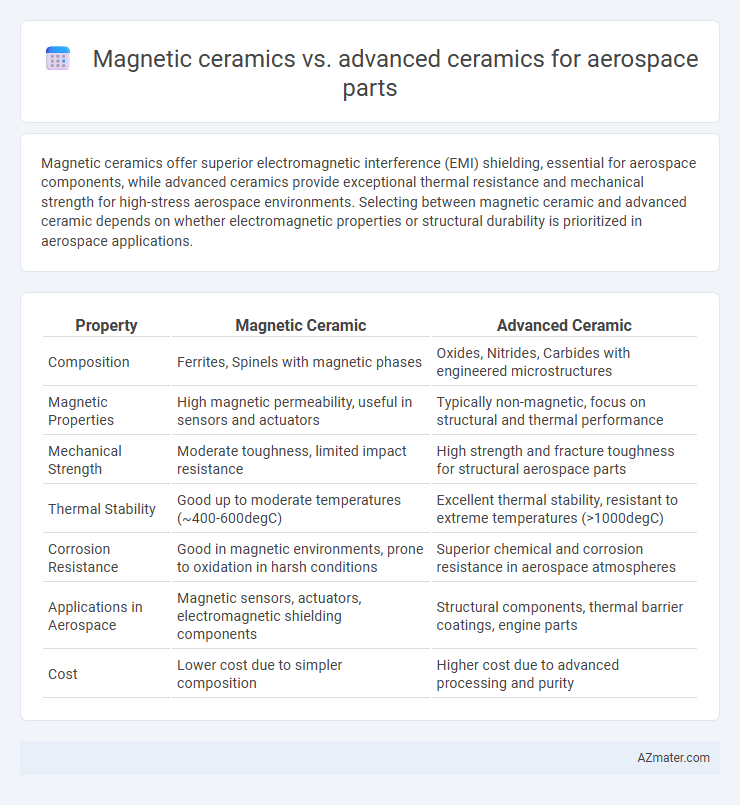Magnetic ceramics offer superior electromagnetic interference (EMI) shielding, essential for aerospace components, while advanced ceramics provide exceptional thermal resistance and mechanical strength for high-stress aerospace environments. Selecting between magnetic ceramic and advanced ceramic depends on whether electromagnetic properties or structural durability is prioritized in aerospace applications.
Table of Comparison
| Property | Magnetic Ceramic | Advanced Ceramic |
|---|---|---|
| Composition | Ferrites, Spinels with magnetic phases | Oxides, Nitrides, Carbides with engineered microstructures |
| Magnetic Properties | High magnetic permeability, useful in sensors and actuators | Typically non-magnetic, focus on structural and thermal performance |
| Mechanical Strength | Moderate toughness, limited impact resistance | High strength and fracture toughness for structural aerospace parts |
| Thermal Stability | Good up to moderate temperatures (~400-600degC) | Excellent thermal stability, resistant to extreme temperatures (>1000degC) |
| Corrosion Resistance | Good in magnetic environments, prone to oxidation in harsh conditions | Superior chemical and corrosion resistance in aerospace atmospheres |
| Applications in Aerospace | Magnetic sensors, actuators, electromagnetic shielding components | Structural components, thermal barrier coatings, engine parts |
| Cost | Lower cost due to simpler composition | Higher cost due to advanced processing and purity |
Introduction to Ceramic Materials in Aerospace
Magnetic ceramics in aerospace applications often provide specialized functions such as electromagnetic interference shielding and sensor integration, leveraging their unique ferromagnetic or ferrimagnetic properties. Advanced ceramics, including silicon carbide and alumina, are valued for their exceptional strength-to-weight ratio, thermal stability, and corrosion resistance crucial in high-temperature aerospace environments. Both types of ceramics are integral to aerospace parts, with magnetic ceramics enhancing electronic performance and advanced ceramics improving structural integrity and durability.
Overview of Magnetic Ceramics
Magnetic ceramics, known for their ferrite composition, exhibit excellent magnetic permeability and electrical insulation, making them essential for aerospace applications requiring electromagnetic interference (EMI) shielding and signal filtering. These materials offer durability under high temperature and stress conditions, providing reliable performance in harsh aerospace environments. Compared to advanced ceramics, magnetic ceramics prioritize magnetic functionality while maintaining sufficient mechanical strength for aerospace components.
Overview of Advanced Ceramics
Advanced ceramics used in aerospace parts exhibit exceptional mechanical strength, thermal stability, and resistance to corrosion, making them ideal for high-performance applications. Unlike magnetic ceramics, which primarily focus on electromagnetic properties, advanced ceramics encompass materials such as silicon carbide, alumina, and zirconia that enhance durability and reliability under extreme environmental conditions. These materials improve fuel efficiency, reduce weight, and extend component lifespan in aerospace engineering.
Key Material Properties Comparison
Magnetic ceramics exhibit high magnetic permeability and excellent electrical insulation, making them suitable for electromagnetic shielding and sensor applications in aerospace. Advanced ceramics offer superior mechanical strength, thermal stability, and wear resistance, essential for structural aerospace components exposed to extreme environments. The choice between magnetic and advanced ceramics depends on the application requirements for magnetic functionality versus mechanical and thermal performance in aerospace parts.
Performance in Extreme Aerospace Environments
Magnetic ceramics exhibit superior electromagnetic properties and thermal stability, enabling precise sensor functionality and electromagnetic interference shielding in extreme aerospace environments. Advanced ceramics offer exceptional mechanical strength, oxidation resistance, and thermal shock resilience, crucial for structural components exposed to high temperatures and mechanical stress. Combining both materials enhances performance by optimizing electromagnetic functionality alongside durability under harsh aerospace conditions.
Applications of Magnetic Ceramics in Aerospace
Magnetic ceramics in aerospace are primarily used for electromagnetic interference (EMI) shielding, sensors, and actuators due to their excellent magnetic permeability and thermal stability. These materials enhance signal integrity and reliability in high-frequency communication systems and avionics by mitigating electromagnetic noise. Compared to advanced ceramics, magnetic ceramics offer superior performance in magnetic field applications critical for navigation and control systems in aircraft.
Applications of Advanced Ceramics in Aerospace
Advanced ceramics in aerospace applications offer exceptional thermal stability, wear resistance, and high strength-to-weight ratios, essential for components such as turbine blades, thermal barrier coatings, and sensors. Magnetic ceramics, while beneficial for electromagnetic applications, lack the mechanical robustness and temperature tolerance required for critical aerospace structural parts. The ability of advanced ceramics to withstand extreme temperatures and corrosive environments makes them ideal for engine components and heat shields in modern aerospace engineering.
Cost-Efficiency and Manufacturing Considerations
Magnetic ceramics offer cost-efficient manufacturing due to lower raw material expenses and simpler production processes compared to advanced ceramics, which require high-purity materials and complex sintering techniques. Advanced ceramics provide superior mechanical and thermal properties essential for aerospace parts, but their manufacturing involves higher energy consumption and longer production cycles, increasing overall costs. Choosing between magnetic and advanced ceramics depends on balancing cost-efficiency with the performance requirements of specific aerospace applications.
Recent Innovations and Research Trends
Recent innovations in magnetic ceramics for aerospace applications focus on enhancing electromagnetic interference shielding and thermal stability, utilizing nanostructured ferrites and cobalt-based spinels to improve magnetic permeability and corrosion resistance. Advanced ceramics in aerospace benefit from developments in ultra-high temperature ceramics (UHTCs) such as zirconium diboride and hafnium carbide composites, which offer superior oxidation resistance and mechanical strength at extreme temperatures. Research trends emphasize integrating additive manufacturing techniques with tailored microstructures to optimize both magnetic and structural performance for next-generation aerospace components.
Conclusion: Selection Criteria for Aerospace Parts
Magnetic ceramics offer tailored electromagnetic properties ideal for components requiring efficient energy conversion and signal transmission in aerospace applications. Advanced ceramics provide superior mechanical strength, thermal resistance, and chemical stability essential for structural parts exposed to extreme environmental conditions. Selecting the appropriate ceramic material depends on prioritizing performance metrics such as electromagnetic functionality versus mechanical durability and thermal resilience in the aerospace environment.

Infographic: Magnetic ceramic vs Advanced ceramic for Aerospace part
 azmater.com
azmater.com